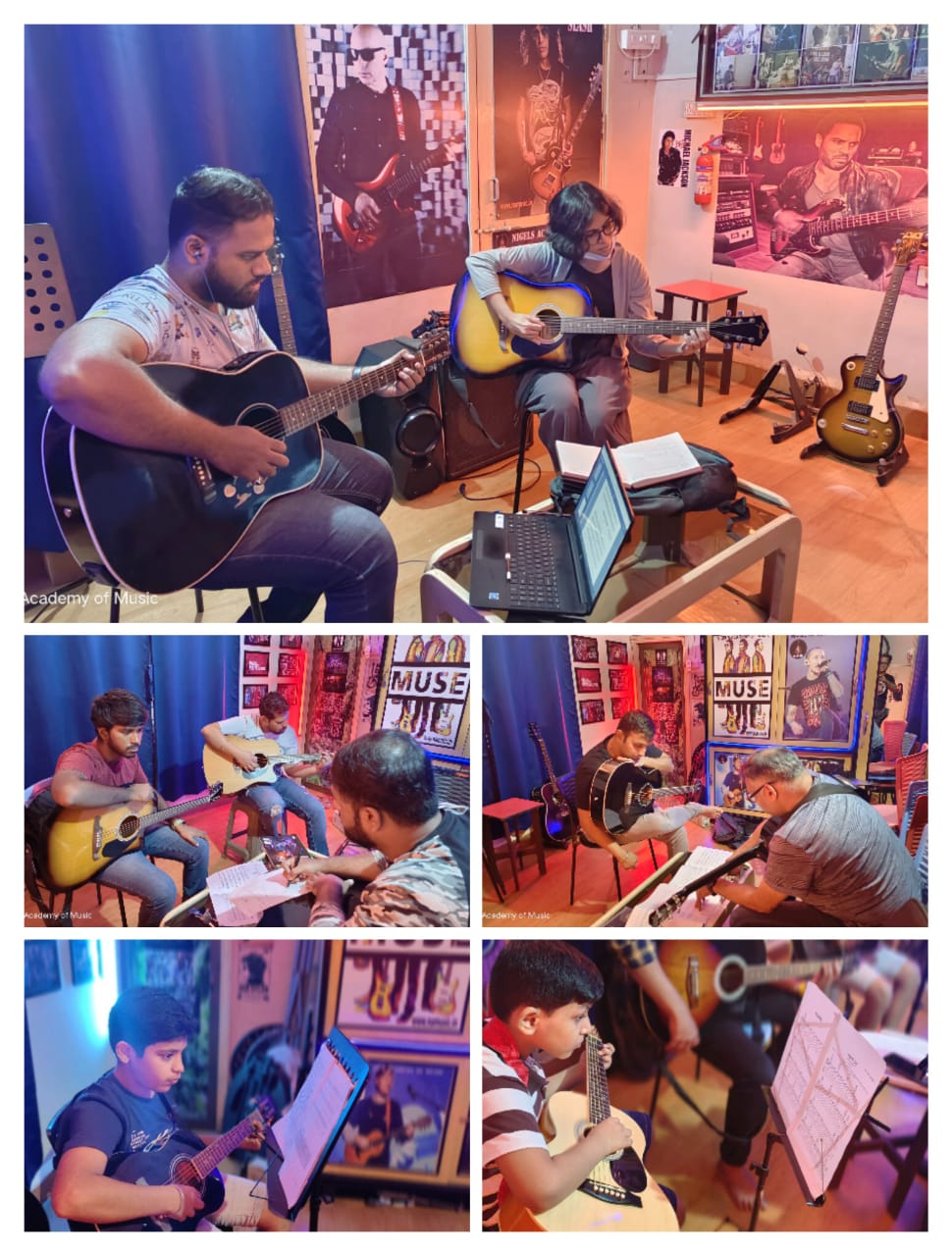Learn simple to complex strumming patterns, playing by reading and ear training, scales and chords, playing acoustic to electric guitar, from basic to advanced notes covering all genres of music from Rock n Roll to Jazz, Pop to R& B
We ensure that each student receives personal attention and hence our batch sizes are determined accordingly.
Age Group: 7 + years Timings Wed- 7-8PM Friday 6-7PM Sat 10-11-12-1 PM Sunday 11-12-1 Pm , 4-5PM Call 8928389882
We ensure that each student receives personal attention and hence our batch sizes are determined accordingly. We not only make you look like a rockstar but sound like one too.
Steps to Enroll: We believe in keeping things simple and easy.All you have to do is call us on 9768199228 make a payment https://www.namusic.in/fee-payment/ select your timings and your ready to take your first class .
INSTAGRAM https://www.instagram.com/nigels.academy/channel/
YOUTUBE https://www.youtube.com/c/NigelsAcademyofMusic/playlists
FACEBOOK https://www.facebook.com/NAM.MUSIC.IN/
Select from the courses below depending upon your area of interest in the field of Music.
Fix an appointment with us.Discuss your interests with us and be assured to be guided in the right direction in case you are unable to make a choice.
Information on the syllabus of each course will be provided at your visit to the Academy.
Enroll for our 3 months, 6 months or 12 month sessions.
Get ready to Rock and Roll!

Basic Professional Course
Applicable for beginners with no prior experience of playing the instrument. You can opt for this course if your next step is to advance your knowledge of the instrument and play professionally ( ONLINE )

Advanced Professional Course
Applicable for Musicians with minimum 1 year experience of playing the instrument. We will teach you the theory of Music (Read and Write), along with sight reading. You will be trained as per the Trinity college of London syllabus which will enable you to appear for the exams starting from Initial to Grade 8 covering Rock or Pop or the Classical Syllabus.
Depending upon individual capability, each grade can be completed within a minimum time period of 3 to 4 months

Hobby Class
Applicable for those who wish to learn the instrument as a therapeutic experience and not pursue a career in music. The course will help you play basic simple songs and can be a fun activity if you love music.

You can enroll in our 3 /6/12 month courses depending upon the level of learning you wish to acquire.
3 Months-12 Sessions
6 Months-24 Sessions
12 Months-48 Sessions + (Minimum 20 Rehearsal sessions)*
*NOT APPLICABLE FOR HOBBY CLASS
Glossary of Guitar Terms
3/4-size guitar
A smaller than normal guitar with shorter strings and less space between frets.
action
A term referring to the height of the strings above the frets and fretboard.
altered and open tunings
The result of changing the tuning of one or more strings from standard EADGBE.
alternate picking
Picking in alternate directions (down-up-down-up).
arpeggio
A broken chord, usually played evenly low to high and back again.
arrangement
The setting of an original or standard tune for a given solo instrument or group of instruments
barre chord
From the French term barré. The technique of placing the left hand index finger over two to six strings in the fingering of a chord. The great advantage of using barre chords is that they are “moveable shapes” that can be applied at practically any fret.
bending
The act of pushing or pulling a string sideways across the a fret to raise the pitch of a note by a half to full tone or more. Used extensively in rock and blues playing as well as in jazz.
capo
A mechanical barre that attaches to the neck of a guitar by means of a string, spring, elastic or nylon band, or a lever and thumbscrew arrangement. The capo can be used to raise the key of a song to suit a vocalist as well as to lower the action and shorten the string length.
chord
Three or more notes sounded simultaneously.
chorus (of a tune)
Strictly speaking, the portion of a song lyric or melody that is repeated, often with other voices joining in. In jazz improvisation, however, “playing a chorus” would mean taking a turn improvising over the tune’s chords progression.
closed voicing
The term “voicing” refers to the vertical arrangement of the notes of a given chord. “Closed voicing” places the member notes as close together as possible, no matter the inversion as opposed to “open voicing” which spreads the member notes of the chord at larger intervals.
cutaway
A concave area generally in the upper right bout of a normal right-hand guitar that allows the player easier access to the high frets.
dropped-D tuning
The practice of lowering the sixth string (E) by a whole tone, one octave lower than the fourth string.
finger picks
Banjo-style picks that fingerstyle guitarists use when playing steel-string instruments.
fingerstyle
Playing with the fingernails or fingertips with or without fingerpicks as opposed to playing with a flatpick.
flatpick
A triangular or teardrop-shaped piece of nylon or plastic used to pluck or strum guitar strings. Flatpicks are available in a large variety of shapes, sizes, and thickness.
footstool
A small adjustable stool used to raise the height of the guitar.
hammer-on
A note sounded literally by “hammering” down with a left hand finger, often performed in conjunction with a note first plucked by the right hand on the same string.
harmonics
Chime-like sounds achieved in two ways: 1) natural harmonics – by touching a string at any equidistant division of the string length (typically 5th, 7th, and 12th fret), directly above the fret with left hand, and striking hard with the right-hand fingers or pick near the bridge where there is more string resistance; or 2) artificial harmonics – touching a string with the index finger of the right hand twelve frets higher than any fretted note and plucking the string with either the thumb or third finger of the right hand.
interval
The distance between two notes.
inversion
Structuring a chord with a note other than the root as the lowest note.
lead guitar
The part played by a guitar soloist in a rock band
modulate
To change keys within a piece of music
open voicing
A manner of chord construction in which the member notes are broadly separated. See closed voicing above.
pentatonic scale
A five-tone scale used often in rock.
picking
Plucking or producing a sound on the guitar in general, either with the fingers or a flatpick. Sometimes refers to playing a single-note melody line.
p i m a
letters derived from the Spanish names for the fingers of the right hand: pulgar (thumb), indice (index), medio (middle), and anular (ring). Used to indicate fingering.
plectrum
Another name for a flatpick.
positions
A reference to placement of the left hand index finger at various frets.
power chord
A chord consisting of the first (root), fifth and eighth degree (octave) of the scale. Power chords are typically used in playing rock music.
pull-off
The opposite of a hammer-on. Performed by plucking a note with a finger on a higher note and pulling parallel to the fret to sound a lower note on the same string.
rhythm guitar
Rhythmic strumming of chord backup for a lead player, singer, or ensemble.
setup
The adjustment of the action of a guitar for optimal playing characteristics.
slide
A plastic or glass tube placed over the third or fourth finger of the left hand and used to play “slide” or glissando effects in rock and blues and other forms of traditional music.
standard tuning
The guitar is generally tuned EADGBE low to high.
string winder
A swivel device with a handle with a fixture that fits over the tuning keys.
strumming
Performed with a pick or the fingers. Generally consists of brushing across 2-6 strings in a rhythmic up and down fashion appropriate to the tune being played.
tablature or tab
A system of writing music for fretted instruments whereby a number or letter appears on lines representing the strings, indicating the fret to be played.
transcription
To write a solo, note for note, off of a recording.
transpose
To change the key of a piece of music by a specific interval.
tremolo
A technique performed with either a very rapid down-up movement of the pick or a pami plucking of the fingers.
triad
A three-note chord.
tuner
An electronic tuning device.
vibrato
To vibrate by slightly altering a pitch higher and lower.
voicing
The arrangement of the member notes of a chord, or placement of the melody or bass line within a harmonic progression


